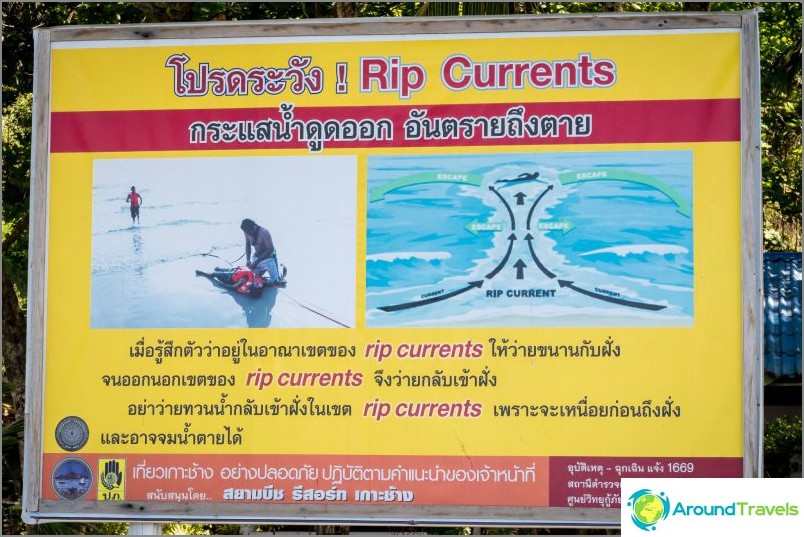A lot of applied, reporting and entertaining texts on the topic have been written on the Internet. «what a tourist needs to know before going to the sea», but it is this article that makes sense to read with utmost attention and seriousness. If you are going to the sea, no matter what it is and where - you should know this information. 95% of drowned people in the world died precisely because they did not know about RIP-currents or rip-currents. Do you know how the abbreviation RIP stands? «Rest in peace» in English means «rip».
The content of the article
- one What are reverse flows
- 2 What are the rip currents
- 3 What is the danger of such currents
- 4 How to escape in a rip current
- five How to understand where there are rips
What are reverse flows
This is a stream of water perpendicular to the shore. If you do not go into the scientific description of the occurrence of countercurrents, then on the fingers the explanation looks like this. Waves, surf, which boils constantly along the edge of the coast, under the water wash up a smooth ridge of sand. A mound, a ridge, a wall, a scythe - call it what you want. This ridge is not visible from the shore, it stretches under water along the entire line of the beach or only partially, it is constantly present there or it washes only at certain times of the year (and sometimes at different times of the day) - but it is there. You probably yourself remember that there is such a bottom, which becomes deeper literally from the second step, and after another couple of steps it suddenly becomes shallow, and you begin to climb a small slope under water. It's him.
A rip current occurs when, at its weakest point, a sandy ridge cannot withstand the pressure of the rolling water and erodes it. Do you understand, yes? A hole appears in the underwater wall, and all the water to the right and left of the hole, trapped by this wall, rushes into it, creating an instant, incredibly strong and very narrow stream of water that knocks down like a mountain river and carries a person away from the shore into the open sea. Well, in the case of an underwater spit, which does not stretch along the entire coast - at the very edge of the spit, an underwater jet arises with each outgoing wave due to the difference in the volume of water outflow. Where nothing interferes with the water, the sea simply moves back. The scythe, preventing the outflow of the lower layers of water, makes them accelerate.

Reverse current at sea (rip-currents)
What are the rip currents
According to some reports, the rip width can vary from 2-3 to 50 meters, and the current speed can reach from 4 to 16 km / h. And if at minimum rates you get off with a slight fright, then hitting a large rip that can drag you into the sea for half a kilometer, it is very important not to panic and remember everything that you are reading now..
Rip current, it is a counter current, it is also a rip current, a pulling current, a ripple wave - is found on most of the oceanic beaches of the world. Where a rescue service is organized and the beach is more or less under the supervision of the state or an adjacent hotel, identification signs are always installed in areas where rip currents are present and there are information boards with short instructions «What to do, if…».
And there are spontaneous rip currents that arise each time in a new place and with different characteristics. It is they who are the most terrible, dangerous in their unpredictability. A mother and a child are standing in water up to their waist, four hours already playing in one place and everything is fine. Then noise, foam, mother and child do not even have time to shout, as it turns out to be a hundred meters from the shore. It's very scary.
What is the danger of such currents
It is an incredible, paralyzing horror when you don’t understand what is happening and you see that the shore is getting further and further, and no one on the shore also understands how to help and what needs to be done. What is sad is that even a husband or a passer-by who has jumped after him, who does not know about the rip current and how to deal with it, has every chance of dying. Did I manage to scare you? Do you understand how serious this is? So here.
People are not killed by the sea, not by rip currents, or even weak swimming skills - but by panic. Panic interferes with assessing the situation, making a decision, panic interferes with everything and pushes the majority of morally unprepared people to the most obvious, but most disastrous act - rowing back to the shore. Even an Olympic champion is not able to row against the current at a speed of 15 km / h. I'm not going to have a nightmare right now - swimming masters, strong, trained athletes, were drowning in rips. After all, you need to row not just quickly, but faster than the flow in order to get to the shore. Panic makes people wave their arms until they are exhausted, which leads to their death.
How to escape in a rip current
The rip is just a stream a few steps wide, and to get out of it you just need to row not to the shore, but to the side. You are in the river, which means that now it is the calm sea that is the shore and salvation for you, swim to it. Do not resist the flow, swim, gradually raking to the side, the primary task for you is to get out of the flow. And if you find so much courage in yourself, then lie on your back and wait - in a minute or two the stream will let you go. After that, swim away and start returning to the shore..
It is very important to save strength and breathing, not to allow panic to paralyze the will. A rip current is not a whirlpool, it does not pull to the bottom. While you swim out - on the shore they will already figure out how to help you and let Buddha if you were sane and swam on the beach with lifeguards, and not somewhere in the wilderness. And I will not say anything about the case if you still do not know how to swim. Although no, I will have one piece of advice for you - buy a PPE board for swimming, tie it to your wrist and enter the sea only where there are no prohibitive flags and where a person with a lifebuoy is on duty on the tower.
How to understand where there are rips
The main sign of danger of rip is red flags and a lifeguard running along the beach who waves his hands and swears at you in all languages of the world. But rip currents also have other external signs that will help you spot danger even without flags in the sand:
- Rip is a river in the sea. If in the general pattern of the waves you see seething water or a clear strip perpendicular to the shore - this is it.
- Difference in color of sea water. The whole beach is blue, and in one place the water brightens to white - this is a rip.
- Marine debris, algae, foam that move in an unusually organized manner from the coast to the sea is a rip.
P.S. Don't get caught in the rip. And if you get there, don't panic.


